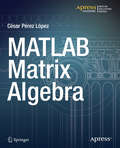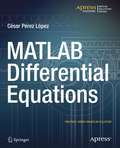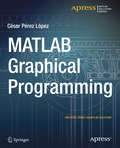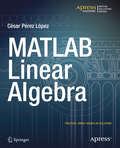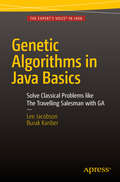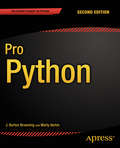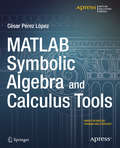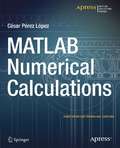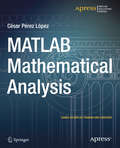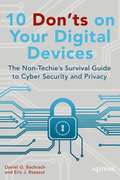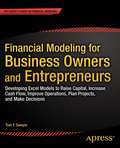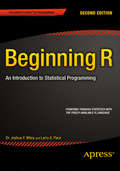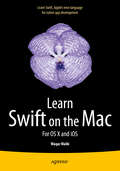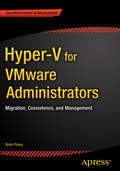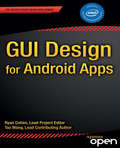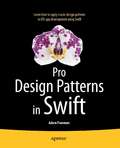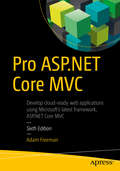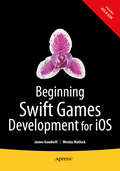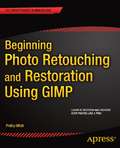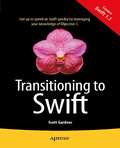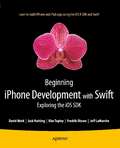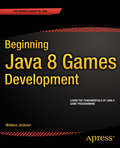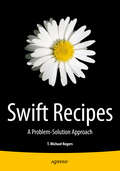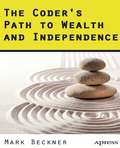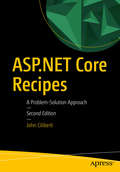- Table View
- List View
MATLAB Matrix Algebra
by Cesar LopezMATLAB is a high-level language and environment for numerical computation, visualization, and programming. Using MATLAB, you can analyze data, develop algorithms, and create models and applications. The language, tools, and built-in math functions enable you to explore multiple approaches and reach a solution faster than with spreadsheets or traditional programming languages, such as C/C++ or Java. MATLAB Matrix Algebra introduces you to the MATLAB language with practical hands-on instructions and results, allowing you to quickly achieve your goals. Starting with a look at symbolic and numeric variables, with an emphasis on vector and matrix variables, you will go on to examine functions and operations that support vectors and matrices as arguments, including those based on analytic parent functions. Computational methods for finding eigenvalues and eigenvectors of matrices are detailed, leading to various matrix decompositions. Applications such as change of bases, the classification of quadratic forms and how to solve systems of linear equations are described, with numerous examples. A section is dedicated to sparse matrices and other types of special matrices. In addition to its treatment of matrices, you will also learn how MATLAB can be used to work with arrays, lists, tables, sequences and sets.
MATLAB Differential Equations
by Cesar LopezMATLAB is a high-level language and environment for numerical computation, visualization, and programming. Using MATLAB, you can analyze data, develop algorithms, and create models and applications. The language, tools, and built-in math functions enable you to explore multiple approaches and reach a solution faster than with spreadsheets or traditional programming languages, such as C/C++ or Java.MATLAB Differential Equations introduces you to the MATLAB language with practical hands-on instructions and results, allowing you to quickly achieve your goals. In addition to giving an introduction to the MATLAB environment and MATLAB programming, this book provides all the material needed to work on differential equations using MATLAB. It includes techniques for solving ordinary and partial differential equations of various kinds, and systems of such equations, either symbolically or using numerical methods (Euler’s method, Heun’s method, the Taylor series method, the Runge–Kutta method,…). It also describes how to implement mathematical tools such as the Laplace transform, orthogonal polynomials, and special functions (Airy and Bessel functions), and find solutions of finite difference equations.
MATLAB Graphical Programming: Practical hands-on MATLAB solutions
by Cesar LopezMATLAB enables you to work with its graphics capabilities in almost all areas of the experimental sciences and engineering. The commands that MATLAB implements in job related graphics are quite useful and are very efficient.MATLAB has functions for working with two-dimensional and three-dimensional graphics, statistical graphs, curves and surfaces in explicit, implicit, parametric and polar coordinates. It also works perfectly with twisted curves, surfaces, volumes and graphical interpolation. MATLAB Graphical Programming addresses all these issues by developing the following topics:This book is a reference designed to give you a simple syntax example of the commands and to graph it so that you can see the result for:
MATLAB Linear Algebra
by Cesar LopezMATLAB is a high-level language and environment for numerical computation, visualization, and programming. Using MATLAB, you can analyze data, develop algorithms, and create models and applications. The language, tools, and built-in math functions enable you to explore multiple approaches and reach a solution faster than with spreadsheets or traditional programming languages, such as C/C++ or Java. MATLAB Linear Algebra introduces you to the MATLAB language with practical hands-on instructions and results, allowing you to quickly achieve your goals. In addition to giving an introduction to the MATLAB environment and MATLAB programming, this book provides all the material needed to work in linear algebra with ease. In addition to exploring MATLAB’s matrix algebra capabilities, it describes the MATLAB commands that are used to create two- and three-dimensional graphics, including explicit, implicit and parametric curve and surface plotting, and various methods of data representation. Methods for solving systems of equations are detailed.
Genetic Algorithms in Java Basics
by Lee Jacobson Burak KanberGenetic Algorithms in Java Basics is a brief introduction to solving problems using genetic algorithms, with working projects and solutions written in the Java programming language. This brief book will guide you step-by-step through various implementations of genetic algorithms and some of their common applications, with the aim to give you a practical understanding allowing you to solve your own unique, individual problems. After reading this book you will be comfortable with the language specific issues and concepts involved with genetic algorithms and you'll have everything you need to start building your own. Genetic algorithms are frequently used to solve highly complex real world problems and with this book you too can harness their problem solving capabilities. Understanding how to utilize and implement genetic algorithms is an essential tool in any respected software developers toolkit. So step into this intriguing topic and learn how you too can improve your software with genetic algorithms, and see real Java code at work which you can develop further for your own projects and research.Guides you through the theory behind genetic algorithmsExplains how genetic algorithms can be used for software developers trying to solve a range of problemsProvides a step-by-step guide to implementing genetic algorithms in Java
Pro Python: Features And Tools For Professional Development
by Marty Alchin J. Burton BrowningYou’ve learned the basics of Python, but how do you take your skills to the next stage? Even if you know enough to be productive, there are a number of features that can take you to the next level in Python. Pro Python, Second Edition explores concepts and features normally left to experimentation, allowing you to be even more productive and creative.In addition to pure code concerns, Pro Python develops your programming techniques and approaches, which will help make you a better Python programmer. This book will improve not only your code but also your understanding and interaction with the many established Python communities.This book takes your Python knowledge and coding skills to the next level. It shows you how to write clean, innovative code that will be respected by your peers. With this book, make your code do more with introspection and meta-programming. And learn and later use the nuts and bolts of an application, tier-by-tier as a complex case study along the way.For more information, including a link to the source code referenced in the book, please visit http://propython.com/.
MATLAB Symbolic Algebra and Calculus Tools
by Cesar LopezMATLAB is a high-level language and environment for numerical computation, visualization, and programming. Using MATLAB, you can analyze data, develop algorithms, and create models and applications. The language, tools, and built-in math functions enable you to explore multiple approaches and reach a solution faster than with spreadsheets or traditional programming languages, such as C/C++ or Java.MATLAB Symbolic Algebra and Calculus Tools introduces you to the MATLAB language with practical hands-on instructions and results, allowing you to quickly achieve your goals. Starting with a look at symbolic variables and functions, you will learn how to solve equations in MATLAB, both symbolically and numerically, and how to simplify the results. Extensive coverage of polynomial solutions, inequalities and systems of equations are covered in detail. You will see how MATLAB incorporates vector, matrix and character variables, and functions thereof. MATLAB is a powerful symbolic manipulator which enables you to factorize, expand and simplify complex algebraic expressions over all common fields (including over finite fields and algebraic field extensions of the rational numbers). With MATLAB you can also work with ease in matrix algebra, making use of commands which allow you to find eigenvalues, eigenvectors, determinants, norms and various matrix decompositions, among many other features. Lastly, you will see how you can use MATLAB to explore mathematical analysis, finding limits of sequences and functions, sums of series, integrals, derivatives and solving differential equation.
MATLAB Numerical Calculations
by Cesar LopezMATLAB is a high-level language and environment for numerical computation, visualization, and programming. Using MATLAB, you can analyze data, develop algorithms, and create models and applications. The language, tools, and built-in math functions enable you to explore multiple approaches and reach a solution faster than with spreadsheets or traditional programming languages, such as C/C++ or Java. This book is designed for use as a scientific/business calculator so that you can get numerical solutions to problems involving a wide array of mathematics using MATLAB. Just look up the function you want in the book and you are ready to use it in MATLAB or use the book to learn about the enormous range of options that MATLAB offers.MATLAB Numerical Calculations focuses on MATLAB capabilities to give you numerical solutions to problems you are likely to encounter in your professional or scholastic life. It introduces you to the MATLAB language with practical hands-on instructions and results, allowing you to quickly achieve your goals. Starting with a look at basic MATLAB functionality with integers, rational numbers and real and complex numbers, and MATLAB's relationship with Maple, you will learn how to solve equations in MATLAB, and how to simplify the results. You will see how MATLAB incorporates vector, matrix and character variables, and functions thereof. MATLAB is a powerful tool used to defined, manipulate and simplify complex algebraic expressions. With MATLAB you can also work with ease in matrix algebra, making use of commands which allow you to find eigenvalues, eigenvectors, determinants, norms and various matrix decompositions, among many other features. Lastly, you will see how you can write scripts and use MATLAB to explore numerical analysis, finding approximations of integrals, derivatives and numerical solutions of differential equations.
MATLAB Mathematical Analysis
by Cesar LopezMATLAB Mathematical Analysis is a reference book that presents the techniques of mathematical analysis through examples and exercises resolved with MATLAB software. The purpose is to give you examples of the mathematical analysis functions offered by MATLAB so that you can use them in your daily work regardless of the application. The book supposes proper training in the mathematics and so presents the basic knowledge required to be able to use MATLAB for calculational or symbolic solutions to your problems for a vast amount of MATLAB functions.The book begins by introducing the reader to the use of numbers, operators, variables and functions in the MATLAB environment. Then it delves into working with complex variables. A large section is devoted to working with and developing graphical representations of curves, surfaces and volumes. MATLAB functions allow working with two-dimensional and three-dimensional graphics, statistical graphs, curves and surfaces in explicit, implicit, parametric and polar coordinates. Additional work implements twisted curves, surfaces, meshes, contours, volumes and graphical interpolation.The following part covers limits, functions, continuity and numerical and power series. Then differentiation is addressed in one and several variables including differential theorems for vector fields. Thereafter the topic of integration is handled including improper integrals, definite and indefinite integration, integration in multiple variables and multiple integrals and their applications.Differential equations are exemplified in detail, Laplace transforms, Tayor series, and the Runga-Kutta method and partial differential equations.
10 Don'ts on Your Digital Devices: The Non-Techie's Survival Guide to Cyber Security and Privacy
by Eric Rzeszut Daniel BachrachIn nontechnical language and engaging style, 10 Don’ts on Your Digital Devices explains to non-techie users of PCs and handheld devices exactly what to do and what not to do to protect their digital data from security and privacy threats at home, at work, and on the road. These include chronic threats such as malware and phishing attacks and emerging threats that exploit cloud‐based storage and mobile apps.It’s a wonderful thing to be able to use any of your cloud-synced assortment of desktop, portable, mobile, and wearable computing devices to work from home, shop at work, pay in a store, do your banking from a coffee shop, submit your tax returns from the airport, or post your selfies from the Oscars. But with this new world of connectivity and convenience comes a host of new perils for the lazy, the greedy, the unwary, and the ignorant. The 10 Don’ts can’t do much for the lazy and the greedy, but they can save the unwary and the ignorant a world of trouble.10 Don’ts employs personal anecdotes and major news stories to illustrate what can—and all too often does—happen when users are careless with their devices and data. Each chapter describes a common type of blunder (one of the 10 Don’ts), reveals how it opens a particular port of entry to predatory incursions and privacy invasions, and details all the unpleasant consequences that may come from doing a Don’t. The chapter then shows you how to diagnose and fix the resulting problems, how to undo or mitigate their costs, and how to protect against repetitions with specific software defenses and behavioral changes.Through ten vignettes told in accessible language and illustrated with helpful screenshots, 10 Don’ts teaches non-technical readers ten key lessons for protecting your digital security and privacy with the same care you reflexively give to your physical security and privacy, so that you don’t get phished, give up your password, get lost in the cloud, look for a free lunch, do secure things from insecure places, let the snoops in, be careless when going mobile, use dinosaurs, or forget the physical—in short, so that you don’t trust anyone over…anything.Non-techie readers are not unsophisticated readers. They spend much of their waking lives on their devices and are bombarded with and alarmed by news stories of unimaginably huge data breaches, unimaginably sophisticated "advanced persistent threat" activities by criminal organizations and hostile nation-states, and unimaginably intrusive clandestine mass electronic surveillance and data mining sweeps by corporations, data brokers, and the various intelligence and law enforcement arms of our own governments. The authors lift the veil on these shadowy realms, show how the little guy is affected, and what individuals can do to shield themselves from big predators and snoops.
Financial Modeling for Business Owners and Entrepreneurs: Developing Excel Models to Raise Capital, Increase Cash Flow, Improve Operations, Plan Projects, and Make Decisions
by Tom Y. SawyerFinancial Modeling for Business Owners and Entrepreneurs: Developing Excel Models to Raise Capital, Increase Cash Flow, Improve Operations, Plan Projects, and Make Decisions may be one of the most important books any entrepreneur or manager in a small or medium-sized enterprise will read. It combines logical business principles and strategies with a step-by-step methodology for planning and modeling a company and solving specific business problems. You’ll learn to create operational and financial models in Excel that describe the workings of your company in quantitative terms and that make it far more likely you will avoid the traps and dead ends many businesses fall into.Serial entrepreneur and financial expert Tom Y. Sawyer shows how to break your company down into basic functional and operational components that can be modeled. The result is a financial model that, for example, you can literally take to the bank or bring to local angel investors to receive the funding you need to launch your business or a new product. Or it might be a model that shows with startling clarity that your new product development effort is a likely winner—or loser. Even better, you’ll learn to create models that will serve as guideposts for ongoing operations. You’ll always know just where you are financially, and where you need to be. The models you will learn to build in Financial Modeling for Business Owners and Entrepreneurs can be used to:Raise capital for startup or any stage of growthPlan projects and new initiativesMake astute business decisions, including go/no-go assessmentsAnalyze ROI on your product development and marketing expendituresStreamline operations, manage budgets, improve efficiency, and reduce costsValue the business when it is time to cash out or mergeIn addition to many valuable exercises and tips for using Excel to model your business, this book contains a combination of practical advice born of hard-won lessons, advanced strategic thought, and the insightful use of hard skills. With a basic knowledge of Excel assumed, it will help you learn to think like an experienced business person who expects to make money on the products or services offered to the public. You’ll discover that the financial model is a key management tool that, if built correctly, provides invaluable assistance every step of the entrepreneurial journey.Tom Y. Sawyer has used the principles this book contains to create financial models of numerous startup and early-stage companies, assisting them in planning for and raising the capital that they needed to grow their businesses and ultimately exit with multiples of their initial investment. Financial Modeling for Business Owners and Entrepreneurs, a mini-MBA in entrepreneurship and finance, will show you how you can do the same.Note: This book is an updated version of Sawyer's 2009 title, Pro Excel Financial Modeling.
Beginning R: An Introduction to Statistical Programming
by Larry Pace Joshua WileyBeginning R, Second Edition is a hands-on book showing how to use the R language, write and save R scripts, read in data files, and write custom statistical functions as well as use built in functions. This book shows the use of R in specific cases such as one-way ANOVA analysis, linear and logistic regression, data visualization, parallel processing, bootstrapping, and more. It takes a hands-on, example-based approach incorporating best practices with clear explanations of the statistics being done. It has been completely re-written since the first edition to make use of the latest packages and features in R version 3. R is a powerful open-source language and programming environment for statistics and has become the de facto standard for doing, teaching, and learning computational statistics. R is both an object-oriented language and a functional language that is easy to learn, easy to use, and completely free. A large community of dedicated R users and programmers provides an excellent source of R code, functions, and data sets, with a constantly evolving ecosystem of packages providing new functionality for data analysis. R has also become popular in commercial use at companies such as Microsoft, Google, and Oracle. Your investment in learning R is sure to pay off in the long term as R continues to grow into the go to language for data analysis and research.What You Will Learn:How to acquire and install RHot to import and export data and scriptsHow to analyze data and generate graphicsHow to program in R to write custom functionsHot to use R for interactive statistical explorationsHow to conduct bootstrapping and other advanced techniques
Learn Swift on the Mac: For OS X and iOS
by Waqar MalikThere's a new language in town. Swift is Apple's new, native, fast, and easy to learn programming language for iOS and OS X app development. It's their "Objective-C without the C". If you are an iOS developer or planning to become one, learning Swift is your #1 priority, and Learn Swift on the Mac tells you everything you need to get up to speed, well, swiftly. You'll start with the Swift Playground and an introduction to object-oriented programming so you can immediately see Swift in action. You then learn about all of the key language features like functions and closures, classes, methods, extensions, and how Swift works just as well as Objective-C when it comes to easy memory management with ARC.Finally you'll learn how to use Swift alongside Objective-C as well as with Core Data, and you'll learn how to put all of the pieces together with a health app using Apple's new HealthKit framework.
Hyper-V for VMware Administrators: Migration, Coexistence, and Management
by Brien PoseyLearn to deploy and support Hyper-V, building on what you know about VMware's vSphere. Whether you're looking to run both hypervisors in parallel or migrate completely, Hyper-V for VMware Administrators has everything you need to get started.The book begins with an overview of Hyper-V basics, including common management tasks such as creating a virtual machine and building a virtual network. You'll learn how to deploy a failover cluster to protect against the risk of Hyper-V becoming a single point of failure, and how to make virtual machines fault tolerant. System Center Virtual Machine Manager (SCVMM) is the preferred tool for managing large Hyper-V deployments, so you'll get to know this next and how it differs from VMware's vCenter solution, as well as how to manage a mixed environment including both vSphere and Hyper-V deployments.Like any server migration, a virtual server migration requires careful planning to ensure success. You'll find information here on the specifics of migrating from vSphere to Hyper-V, planning for down time, IP address differences, performance considerations, and more. For migrations to Hyper-V, SCVMM is once again the preferred tool, but you'll also be introduced to some of the excellent free tools available. One easily overlooked aspect of the migration process is the way in which it impacts your backup and recovery strategy. Knowing the best practices here can help you protect your Hyper-V environment. The book also covers how to monitor and maintain your Hyper-V environment once it's up and running, using features like Cluster-Aware Updating, automated live migrations, and availability sets. The concluding chapter shows you how to take advantage of the efficiencies provided by virtual machine libraries and templates.Approach Hyper-V with confidence, and the knowledge that you've planned for success, with Hyper-V for VMware Administrators.
GUI Design for Android Apps
by Ryan Cohen Tao WangGUI Design for Android Apps is the perfect—and concise—introduction for mobile app developers and designers. Through easy-to-follow tutorials, code samples, and case studies, the book shows the must-know principles for user-interface design for Android apps running on the Intel platform, including smartphones, tablets and embedded devices.This book is jointly developed for individual learning by Intel Software College and China Shanghai JiaoTong University, and is excerpted from Android Application Development for the Intel® Platform.
Pro Design Patterns in Swift
by Adam FreemanThe Swift programming language has transformed the world of iOS development and started a new age of modern development. Pro Design Patterns in Swift shows you how to harness the power and flexibility of Swift to apply the most important and enduring design patterns to your applications, taking your development projects to master level.This book will teach you those design patterns that have always been present at some level in your code, but may not have been recognized, acknowledged, or fully utilized. Implementation of specific pattern approaches will prove their value to any Swift developer.Best-selling author Adam Freeman explains how to get the most from design patterns. He starts with the nuts-and-bolts and shows you everything through to advanced features, going in-depth to give you the knowledge you need. Pro Design Patterns in Swift brings design patterns to life and shows you how to bring structure and scale to your Swift code with a practical, no-nonsense approach.
Pro ASP.NET Core MVC
by ADAM FREEMANVisual Studio 2017 updates for this book are now available. Follow the Download Source Code link for this book on the Apress website.Now in its 6th edition, the best selling book on MVC is now updated for ASP.NET Core MVC. It contains detailed explanations of the new Core MVC functionality which enables developers to produce leaner, cloud optimized and mobile-ready applications for the .NET platform. This book puts ASP.NET Core MVC into context and dives deep into the tools and techniques required to build modern, cloud optimized extensible web applications. All the new MVC features are described in detail and the author explains how best to apply them to both new and existing projects.The ASP.NET Core MVC Framework is the latest evolution of Microsoft’s ASP.NET web platform, built on a completely new foundation. It represents a fundamental change to how Microsoft constructs and deploys web frameworks and is free of the legacy of earlier technologies such as Web Forms. ASP.NET Core MVC provides a "host agnostic" framework and a high-productivity programming model that promotes cleaner code architecture, test-driven development, and powerful extensibility.Best-selling author Adam Freeman has thoroughly revised this market-leading book and explains how to get the most from ASP.NET Core MVC. He starts with the nuts-and-bolts and shows you everything through to advanced features, going in-depth to give you the knowledge you need.This book follows the same format and style as the popular previous editions but brings everything up to date for the new ASP.NET Core MVC release. It presents a fully worked case study of a functioning ASP.NET MVC application that readers can use as a template for their own projects.What You Will Learn:Gain a solid architectural understanding of ASP.NET Core MVCExplore the entire ASP.NET MVC Framework as a cohesive wholeSee how MVC and test-driven development work in actionLearn what's new in ASP.NET Core MVC and how best to apply these new features to your own workSee how to create RESTful web services and Single Page ApplicationsBuild on your existing knowledge of previous MVC releases to get up and running with the new programming model quickly and effectivelyWho This Book Is For:This book is for web developers with a basic knowledge of ASP.NET and C# who want to incorporate the latest improvements and functionality in the new ASP.NET Core MVC Framework.
Beginning Swift Games Development for iOS: Updated For Swift 3
by James Goodwill Wesley MatlockGame apps are one of the most popular categories in the Apple iTunes App Store. Well, the introduction of the new Swift programming language will make game development even more appealing and easier to existing and future iOS app developers. In response, James Goodwill, Wesley Matlock and Apress introduce you to this book, Beginning Swift Games Development for iOS. In this book, you'll learn the fundamental elements of the new Swift language as applied to game development for iOS. In part 1, you'll start with a basic 2D game idea and build the game throughout the book introducing each SpriteKit topic as we add new functionality to the game. By the end of the book, you'll have experience with all the important SpriteKit topics and have a fully functional game as a result. In part 2 of this book, you'll learn 3D game development using Apple's SceneKit framework and the Swift programming language. And, you'll follow the same pattern we used for part 1. After reading and using this book, you'll have the skills and the code to build your first 2D and then 3D game app that you can run on any iOS enabled device and perhaps sell in the Apple iTunes App Store.
Beginning Photo Retouching and Restoration Using GIMP
by Phillip WhittBeginning Photo Retouching & Restoration Using GIMP teaches the reader how to achieve professional results using this high end image editor. You'll learn how to do everything from making dull images "pop" to resurrecting badly damaged photographs deemed beyond any hope of rescue. There's no need to shell out good money month after month for the "big name" software package. GIMP 2.8 is a world-class image editor that wields almost as much power, and is completely free!Learning the art of photo retouching and restoration is fun and rewarding. Reclaim those treasured images from the ravages of time and neglect, and pass them on to future generations. Beginning Photo Retouching & Restoration Using GIMP will provide you with a wide array of editing exercises to help you develop a high degree of proficiency. Whether you are the designated "family archivist" wanting to preserve your family history, or a professional photographer with a desire to add an extra revenue generating service, this book will be an invaluable aid. • Shows how to acquire the best scans and digitize large photographs.• Teaches you how to digitally repair damaged prints, correct color shifts, reclaim lost detail-even colorize black and white images.• Offers great tips on how to maintain and preserve your newly printed restored photographs, and how to properly store originals.
Transitioning to Swift
by Scott GardnerDeveloping apps for Apple’s broadening platform of devices is an exciting topic these days. Apple created the Swift programming language to build state-of-the-art apps using the latest Apple technologies.In this 200-page book, author Scott Gardner articulates the similarities and differences between traditional Objective-C based programming and Swift, revealing what you need to know from syntax changes to emerging best practices and paradigm shifts, to write powerful, expressive, and flexible code in Swift.Written at a brisk pace and in a methodical style, you'll learn how to apply your Objective-C skills to successfully transition to programming in Swift.In this book, you'll learn:• What is Swift and how does it compare to Objective-C• How to become proficient in Swift by leveraging your existing Objective-C skills• How to take advantage of new capabilities in Swift• What are the emerging best practices in Swift programmingTransitioning to Swift reaches out to all developers who are interested in creating state-of-the-art apps for Apple’s broadening platform of devices for both consumers and enterprise. Apple's introduction of the new Swift programming language raises many questions. This book addresses those questions directly, and prepares developers for building the next generation of apps in Swift to surprise and delight users the world over.
Beginning iPhone Development with Swift: Exploring the iOS SDK
by Kim Topley Fredrik Olsson Jack Nutting David Mark Jeff LaMarcheThe team that brought you the bestselling Beginning iPhone Development, the book that taught the world how to program on the iPhone, is back again for Beginning iPhone Development with Swift. This definitive guide to the Swift programming language and the iOS 8 SDK, and the source code has been updated to reflect Xcode 6.3.1 and Swift 1.2.There’s coverage of brand-new technologies, including Swift playgrounds, as well as significant updates to existing material. You'll have everything you need to create your very own apps for the latest iOS devices. Every single sample app in the book has been rebuilt from scratch using the latest Xcode and the latest 64-bit iOS 8-specific project templates, and designed to take advantage of the latest Xcode features.Assuming little or no working knowledge of the new Swift programming language, and written in a friendly, easy-to-follow style, this book offers a complete soup-to-nuts course in iPhone, iPad, and iPod touch programming. The book starts with the basics, walking through the process of downloading and installing Xcode and the iOS 8 SDK, and then guides you though the creation of your first simple application.From there, you’ll learn how to integrate all the interface elements iOS users have come to know and love, such as buttons, switches, pickers, toolbars, and sliders. You’ll master a variety of design patterns, from the simplest single view to complex hierarchical drill-downs. The art of table building will be demystified, and you’ll learn how to save your data using the iPhone file system. You’ll also learn how to save and retrieve your data using a variety of persistence techniques, including Core Data and SQLite. And there’s much more!
Beginning Java 8 Games Development
by Wallace JacksonBeginning Java 8 Games Development, written by Java expert and author Wallace Jackson, teaches you the fundamentals of building a highly illustrative game using the Java 8 programming language. In this book, you'll employ open source software as tools to help you quickly and efficiently build your Java game applications. You'll learn how to utilize vector and bit-wise graphics; create sprites and sprite animations; handle events; process inputs; create and insert multimedia and audio files; and more. Furthermore, you'll learn about JavaFX 8, now integrated into Java 8 and which gives you additional APIs that will make your game application more fun and dynamic as well as give it a smaller foot-print; so, your game application can run on your PC, mobile and embedded devices. After reading and using this tutorial, you'll come away with a cool Java-based 2D game application template that you can re-use and apply to your own game making ambitions or for fun.
Swift Recipes: A Problem-Solution Approach
by Mike RogersSwift Recipes provides a problem solution approach for dealing with key aspects of the Swift programming language (covering version 1.2), ensuring you have the indispensable reference you need to successfully execute common programming tasks. You’ll learn how to use the unique features of the Swift programming language as well as its use with Cocoa and Cocoa touch frameworks and libraries.Solutions are available for a range of problems, including application development with Xcode; working with strings, numbers, and object collections; dealing with threads, multi-core processing, and asynchronous processing; and building applications that take advantage of dates and timers and memory management.This book is an essential core reference for every Swift programmer and offers solutions in a concise and easy-to-follow manner. T. Michael Rogers has developed iOS applications for Fortune 100 brands and startups, and has trained new and experienced iOS developers via the iOS Boot Camp in New York City, online courses, and in private settings. He brings his expertise to offer you the ability to use and exploit Swift to get the most out of all your projects for your app creations, whether you use iOS or Mac OS X.
The Coder's Path to Wealth and Independence
by Mark BecknerDevelopers, programmers, technical architects, and consultants: You are highly skilled and have deep commitment to your craft as well as the motivation to excel. It’s time to step away from the perceived security of a full-time salaried position, or a marginally successful solo business, and step into a world of freedom, independence, and wealth. With your current technical skills, and an open mind, you can rapidly build a highly successful and ethical business—and on your own terms.The Coder's Path to Wealth and Independence explains how. Mark Beckner, himself, a highly successful itinerant developer, shows you how to transform yourself from a skilled programmer into a highly creative and effective businessperson leveraging the skills you already have. You will learn to create opportunities where none have existed, create value for yourself and those you work with, substantially increase your income, define your ideals, and realize your dreams. By utilizing the unique strategies outlined in The Coder's Path to Wealth and Independence to build your practice, you will find your path to personal, professional, and financial prosperity.The Coder's Path to Wealth and Independence will show you how to:Work from wherever you want Use your technical skills to create a high-revenue, highly independent businessLearn the skills of the "rainmaker" to acquire new projects and clientsOperate under various fee models, allowing you to increase your wealth and your freedomRapidly create proposals and contractsManage projects and execute on your goals with greater skill than everIn short, this book will help you discover a variety of powerful and unique approaches to business that will allow you be highly successful—where, how, and whenever you want.
ASP.NET Core Recipes: A Problem-Solution Approach
by John CilibertiQuickly find solutions to common web development problems. Content is presented in the popular problem-solution format. Look up the problem that you want to solve. Read the solution. Apply the solution directly in your own code. Problem solved!ASP.NET Core Recipes is a practical guide for developers creating modern web applications, cutting through the complexities of ASP.NET, jQuery, React, and HTML5 to provide straightforward solutions to common web development problems using proven methods based on best practices. The problem-solution approach gets you in, out, and back to work quickly while deepening your understanding of the underlying platform and how to develop with it.Author John Ciliberti guides you through the MVC framework and development tools, presenting typical challenges, along with code solutions and clear, concise explanations, to accelerate application development. Solve problems immediately by pasting in code from the recipes, or put multiple recipe solutions together to overcome challenging development obstacles.What You'll LearnTake advantage of MVC's streamlined syntaxDiscover how to take full control over HTMLDevelop a simple API for creating RESTful web servicesUnderstand test-driven developmentMigrate a project from ASP.NET web forms to Core MVC, including recipes for converting DataGrids, Forms, Web Parts, Master Pages, and navigation controlsUse Core MVC in combination with popular JavaScript libraries, including jQuery, React, Bootstrap, and moreWrite unit tests for your MVC controllers, views, custom filters, and HTML helpersUtilize the latest features in Visual Studio 2017 to accelerate your Core MVC projectsIdentify performance bottlenecks in your MVC applicationWho This Book Is ForWeb developers of all skill levels who are looking for a programming reference for ASP.NET Core MVC and would like to gain an understanding of the inner workings of the platform. In addition, parts of this book provide guidance to developers familiar with ASP.NET Web Forms who would like to update their skill set to include Core MVC.
